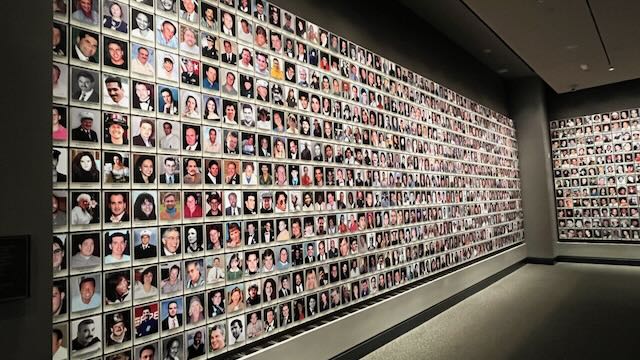
I hadn’t been back to Ground Zero for over twenty years. The last time, it was still a mound of rubble, with construction and removal crews clearing the area where the Twin Towers had stood. I got a tour that day from a man who had driven a garbage truck in New York for his entire adult life. After the World Trade Center fell, he volunteered to drive dump trucks full of ash and debris off the site with tears in his eyes every day for months. It was sad not only listening to him recount his memories of that horrible day, but to know he’d been inhaling all sorts of toxic fumes just by doing his job.
Last week, I returned to the site, which is now home to the 9/11 Memorial and Museum. My visit happened to coincide with the influx of ashen air floating down from wildfires in Canada, turning the sky orange and making breathing outside difficult even with a mask. Local newscasters reported that the NY Fire Department was getting dozens of calls reporting fires that turned out to be nothing but the smoke in the air.
Because of those conditions, the area adjacent to the two memorial pools next to the 9/11 museum — located where the towers had stood — was chained off to keep visitors from lingering for long. It was eerie standing there with the fetid smell of something burning so apparent.
I went into the museum and took a tour, seeing some of the remnants of the long-gone building and listening to a very good tour guide provide details on various exhibits including pieces of the steel infrastructure that had been hopelessly bent out of shape by the impact of the planes that were flown into the towers. Others included remnants of an FDNY truck that was ruined when the towers fell and pieces of the antenna that had been at the top of one of the Twin Towers, transmitting radio, television, and cellphone signals all over Manhattan. There’s also a room with photos of everyone who died that day (plus six more who died in the 1993 bombing of the WTC) along with some of the paraphernalia family members and friends left in their memories. Quite moving.
Towards the end, our tour guide, Kevin, explained in depth how people who worked the site for months in the aftermath of the attack (probably including that truck driver I met long ago) became horribly sick and then had to fight to get Congress to provide funds to cover their extensive medical bills. Shame on those Capitol Hill scumbags who took years — and more than 200 visits from advocates for first responders and others, including Jon Stewart — to do the right thing.
In addition to the tour, I watched a 15-minute scene-setting film with footage from that dreadful Tuesday morning and video of officials who responded to the crisis. One of those was Rudolph Giuliani, who was so praised and popular for the way he led his city through the catastrophe, but now has become a pariah because of his lies on behalf of Trump’s false claims about the 2020 election. The other politician in that introductory film was George W. Bush, who still seems too dumbfounded by the attack to explain his own actions and reactions to the cataclysm.
After leaving the museum, I walked over to the new One World Trade Center building, the tallest in the land, standing 1,776 feet high in all its glass-and-steel glory. I thought I might have a look around the lobby, but when I got to the main doors, I was told only residents and their guests were allowed inside. However, there’s an entrance around the corner for visitors who want to take an ultrafast elevator to the top and look around the 360° view. Prices for that privilege start at $50 (!!!).
Considering the smoky haze that had enveloped the city, I doubted the perspective would be worth it that day. But my visit to the museum and observing semblances of a normal life proceeding all over New York reminded me of that city’s resilience.
